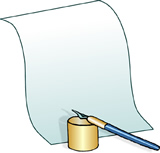Lesson 4.1E: Narratives as Multi-Paragraph Compositions
 Your stories are not just something you can create to entertain. No! Your stories, even very personal stories, can be crafted into legitimate compositions that can be submitted as assignments, and are useful even when writing grade ten provincial exams. This lesson will introduce you to the narrative composition - a popular and enjoyable way to write a multi-paragraph composition. Your stories are not just something you can create to entertain. No! Your stories, even very personal stories, can be crafted into legitimate compositions that can be submitted as assignments, and are useful even when writing grade ten provincial exams. This lesson will introduce you to the narrative composition - a popular and enjoyable way to write a multi-paragraph composition.
As part of this lesson, you will write a multi-paragraph narrative composition. Turn to Section Assignment 4.1F: Your Story - Your Multi-paragraph Narrative Composition, and read the instructions for the assignment. This lesson will walk you through a number of steps to complete your composition.
Your Multi-Paragraph Composition
As you will remember, narratives are simply stories that are written down or spoken. We are all familiar with a narrative style because we all tell stories - to our friends, and to our family.
A narrative composition simply uses the structure of a story to illustrate a main idea.
Therefore, when you write a multi-paragraph narrative composition, you must be sure to include all the conventions of storytelling: plot, character, setting, climax, and conclusion. Moreover, a narrative composition is usually filled with details that are carefully selected to explain, support, or embellish the story. All of the details relate to the main point the writer is attempting to make. In other words, the story has a thesis, a central idea that it will illustrate and prove. This is what makes a narrative composition different from a short story - a short story will leave the message, or theme, to the reader's imagining, whereas a narrative composition will be more straightforward and directly point out the main idea or thesis.
To summarize, the multi-paragraph narrative composition:
- is a story told from your first-person point of view
- makes and supports a central idea or point
- is filled with precise detail and description
- uses characters, plot, setting in order to illustrate the central idea
- may use dialogue
- usually begins with a character in conflict, and then by the end of the composition, the conflict is resolved.
- includes a beginning and ending that explain significance of the story
 One of the best ways to learn about how to write a particular kind of composition is to read a first-rate example. Writers have always read other writers for inspiration and guidance-and so should you. One of the best ways to learn about how to write a particular kind of composition is to read a first-rate example. Writers have always read other writers for inspiration and guidance-and so should you.
So let's take a moment to consider "None of the Above," by Josh Freed, on page 382 of your Sightlines 10 textbook. |

Journal Entry 4.1C: Multi-Paragraph Narrative Composition
After you have read the narrative composition, "None of the Above," answer the following questions in your Journal:
- How does Josh Freed's composition fit the characteristics of a narrative composition as listed in this lesson?
- Do you enjoy this kind of composition more than a formal composition? Why or why not?
|
 Choosing a Topic Choosing a Topic
The first step in creating your own narrative composition is to select a topic. So, here's a strategy for selecting a topic:
Remember that embarrassing moment that taught you so much about what is really important in life? Or that first job? Maybe you recall a driver's test you could not pass, or the wise words from a grandparent or elder? Think of a time of conflict - coming through that experience will have provided you with a valuable life lesson to share with the world. Great! That is all you need to start preparing to write your very own multi-paragraph narrative composition. If you can't think of a topic for your narrative composition, here are a few examples to get you thinking!
- my trip to Alaska
- when Pappy got really sick
- learning to mountain climb
- my struggles with my sister
- finding my birth mother
As you explore the different topics in this lesson, think about how they apply to the story you want to tell.
Select a topic for your multi-paragraph narrative composition. Select the one narrative composition topic that you will most easily be able to write about.
Now it is brainstorm time! The best way to prepare to write is to simply start organizing your ideas on paper. Use the Writing Process Template to brainstorm your ideas. As you brainstorm, consider the following questions:
- What was your conflict?
- What will your central idea, or thesis be?
- What would be some good descriptive details to include?
Open the assignment template for this section to complete this activity.
Writing Process Template pdf
|
You will be asked to submit the Writing Process Template with your section assignment, so keep it close by.
 Outlining Your Multi-Paragraph Narrative Composition Outlining Your Multi-Paragraph Narrative Composition
Since a narrative composition relies on personal experience, and memories and emotions are involved in the writing process more so than in any other composition form, a great deal more time than usual is spent sifting and organizing the details of your narrative before you even get to the writing phase. This pre-writing work will help to make your composition that much stronger and more engaging. One of the most effective ways to prepare for the writing of your composition is to create a detailed outline.
Use the Outline Template to create a detailed outline before you write the assigned multi-paragraph narrative composition. The outline is usually used to prepare a more formal composition.
general statement = catchy opening about the conflict that you encountered
thesis statement = central idea or main point or lesson about life
Open the assignment template for this section to complete the Outline Template.
You will be asked to submit the Outline Template with your section assignment, so keep it close by. Do provide as much detail in your planning as possible.

Summary
Completing this lesson has helped you to:
- understand what a multi-paragraph narrative composition is
- prepare for, and then write, a multi-paragraph narrative composition
Section Summary
You have now completed Section 4.1: Story Telling Traditions. You have explored a number of story telling forms, including Greek mythology, Aboriginal story telling, the ballad, Shakespearean drama, and personal memoirs.
Review the following list to ensure you have completed all assignments for this section.
- Section Assignment 4.1A: Comparing Traditions
- Section Assignment 4.1B: Graphic Ballad
- Section Assignment 4.1.C: Identifying the Bard’s Images
- Section Assignment 4.1D: Your Turn - A Dramatic Reading
- Section Assignment 4.1E: A Secret and the Keeper
- Section Assignment 4.1F: Your Story - Your Multi-paragraph Narrative Composition
- Section Assignment 4.1G: Journal Entries
|

